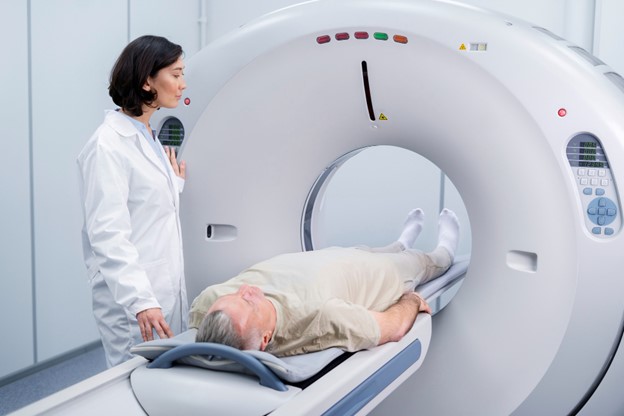A CT KUB scan is a special type of medical test. It focuses on checking your kidneys, ureters, and bladder. Doctors consider this scan important. Why? Because these parts of the body play a crucial role in processing waste. The kidneys filter blood, ureters carry urine from the kidneys to the bladder, and the bladder holds urine until you are ready to release it. Keeping these organs healthy is essential for the body’s overall function.
The CT KUB is often seen as an advanced technology tool. Unlike older methods, such as simple X-rays, this type gives detailed images. This detail helps doctors spot problems early. That means they can treat the issues before they become more serious. So, if a doctor suggests this scan, it’s to get a clear picture of your health.
Delving Into CT KUB: From Procedure to Results
So, what happens during a CT KUB scan? First, let’s compare it to a traditional X-ray. Unlike X-rays, which offer basic images, CT KUB provides a 3D look at the kidneys, ureters, and bladder. This focus helps in diagnosing problems like stones or infections quickly.
Before you go for the scan, there are a few things to keep in mind:
- Eat lightly: Your doctor may suggest eating a light meal before the scan and drinking plenty of fluids.
- Remove metal objects: You need to remove jewelry or metal accessories, as they can interfere with the scan.
During the scan, you will lie down on a table. The table then slides into the CT scanner. This machine takes detailed pictures. You might hear some buzzing noises, which is normal. It’s important to stay still for clear images.
After the scan, you can return to your regular activities. The images get analyzed by specialists. They then let your doctor know the results.
Sometimes, doctors might suggest a plain CT KUB or a contrast KUB. What’s the difference?
- Plain CT KUB: This does not involve any dye. It’s often used to see obvious issues.
- Contrast KUB: In this case, you might get a special dye. This makes the images clearer. It’s often used when doctors need to see particular details.
Doctors decide which type is best based on what they need to check. It’s all about choosing the right method for the situation to ensure a safe and effective diagnosis.
Medical Implications: Why CT KUB Scans Are Recommended
CT KUB scans are more than just pictures. They are a powerful tool for identifying various health problems:
- Kidney stones: Small stones can grow big, causing pain. CT ABDOMEN KUB can help spot them early.
- Urinary tract infections (UTIs): These scans help find the source of recurring UTIs.
Doctors also use CT KUB for pre-surgery checks or to monitor cancers in the urinary tract. It’s crucial for planning treatments or surgeries safely.
The technology is safe, too. There are safety features to limit radiation exposure. That ensures it’s within safe levels for patients. Doctors take extra care if there are concerns about radiation, especially for pregnant women or children.
When the right scan is used correctly, it leads to better treatment strategies and healthier outcomes. Whether it’s a plain CT KUB or the more detailed contrast KUB, these tests are a key part of modern medicine, ensuring doctors have the best information for patient care.
Comparative Insights: CT KUB vs. Other Diagnostic Techniques
CT KUB scans offer several advantages over traditional methods. Unlike simple X-rays, these scans provide a more detailed look.
Benefits include:
– Accuracy: It provides precise images, which help in accurate diagnoses. – Efficiency: Faster results mean quicker diagnosis and treatment. – Non-invasive: There’s no need for surgical procedures; it achieves valuable insights simply by taking pictures.
However, like any procedure, there are potential risks. Radiation exposure is a concern, but it’s minimal compared to the benefits. Allergic reactions to the dye used in contrast KUB are rare but possible. Doctors always assess the risks versus the benefits before recommending a scan.
These benefits make CT KUB scans a preferred choice when looking for detailed information about the urinary system. By understanding the pros and cons, patients can make informed decisions with their healthcare providers.
Technological Advances in CT KUB and Its Accessibility in India
CT KUB technology continues to improve. New machines provide even clearer images and work faster. These advancements mean better patient experiences and more precise results. Plus, with technology growing, the accessibility is increasing too.
In India, many hospitals and clinics now offer CT KUB scans. This means more people can access these services. Costs are also becoming more affordable as availability grows. Patients are encouraged to talk to their doctors about whether a CT KUB scan is right for them.
By staying informed and asking questions, individuals can take charge of their health. As technology gets more sophisticated, the hope is that CT KUB scans become a routine tool in diagnostics, making healthcare more proactive and effective.
By understanding CT KUB scans, patients can see why doctors value them. Whether it’s CT ABDOMEN KUB, plain CT KUB, or even contrast KUB, these scans play a critical role in managing health effectively.

